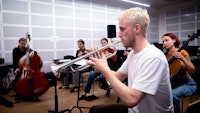Read the report from the project on praxis.nmh.no
Artistic identity
In order to succeed in today’s musical society, and also for the sake of a vibrant and diverse arts scene, it is important that musicians are conscious, curious and autonomous. Life as a musician involves continuous reflection on one’s musical directions: where do I come from, and where do I want to go next? Artistic identity is thus not a stable quantity; it changes as the musician develop and gets new musical experiences in a reciprocal relationship with an ever evolving modern music industry of which the musician is part. The artistic identity or musical profile is in flux, and today’s musicians need skills and routines to be able to regularly consider and review their choices and in which direction they are heading. To support students in becoming robust and flexible practitioners, it is important that the education involve critical thinking regarding possible musical crossroads. What am I really interested in right now? Why and how am I interested in this? What do I want to explore on my next projects? What different directions have I looked into so far? How can I contribute musically in a way that feels meaningful?
ePortfolios
Digital portfolios are collections of student work, such as texts, essays, logs, sound files, videos, images etc. The use of ePortfolios in academic life has largely increased the last decade, and research substantiate its value as tool for reflection and deep learning. Student ePortfolios are used in a large variety of ways. They can be public or private, shared with a group or only one teacher. They can have a focus on process, they can be a place for logging, they can be used for assignments, or as presentation of qualifications, they can be focused around certain topics or subjects, or be about other aspects of student life.
Digital portfolios are also coming to performance studies, and in 2018-19 and 19-20, CEMPE runs a pilot project with eportfolio for music students, called «Core Portfolio». The student’s eportfolio is a tool for reflection on musicianship and development, and can be a central space (core) for organizing and thinking within one’s practice. The portfolio is followed up with meetings with a performer teacher as artistic mentor. The main keywords in the meetings and the portfolios work are looking back and looking forward, overview and logs, identity and taste, integrity and values, musician’s role and context.
Looking over, back, ahead, in
The Core Portfolio project aims to give the students an overview of their learning trajectory by looking back and looking ahead, and through reflection gaining an increased insight in their own artistic development. The students present who they are and what they are concerned with right now, inside the portfolio. They can look back: who am I, and who have I been so far in my musical life? The students make overviews of their music performance work, f.ex repertoire, ensembles, concerts, projects. Through the mentor meetings, with tasks and discussions, the students can reflect on development and crossroads, and look ahead at future directions and new opportunities for exploration.
Togetherness and space for reflection
Verbalizing and discussing musical choices, artistic crossroads and values, can give important insight for a robust and conscious musician. Through the mentor meetings, the students get more people to play ball with and meet a breadth of experiences. The mentor and the main instrument teacher(s) are a team around the student, aiming for a strengthened feeling of togetherness. The Core Portfolios can have pages and collections that are kept private, and that are shared with mentor/teacher. The student can also choose to publish pages and collections in student groups, or publicly. As portfolio content can be kept private, the student can work with it as a personal and safe space for reflection. In this way it can take part in creating a starting point for a life of continuous reflection on and development of an artistic identity.
